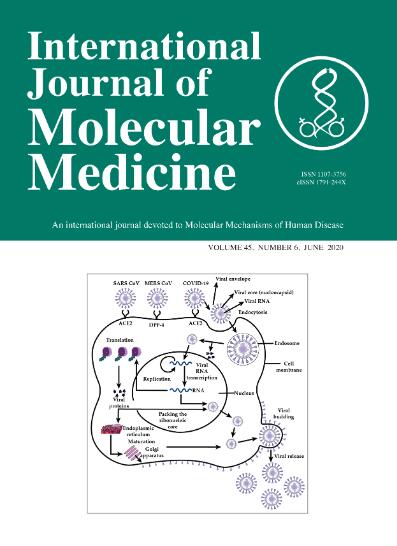An LGR4 agonist activates the GSK‑3β pathway to inhibit RANK‑RANKL signaling during osteoclastogenesis in bone marrow‑derived macrophages.
IF 5.7
3区 医学
Q1 MEDICINE, RESEARCH & EXPERIMENTAL
引用次数: 0
Abstract
The binding between receptor‑activated nuclear factor‑κB (RANK) and the RANK ligand (RANKL) during osteoclast development is an important target for drugs that treat osteoporosis. The leucine‑rich repeat‑containing G‑protein‑coupled receptor 4 (LGR4) acts as a negative regulator of RANK‑RANKL that suppresses canonical RANK signaling during osteoclast differentiation. Therefore, LGR4 agonists may be useful in inhibiting osteoclastogenesis and effectively treating osteoporosis. In the present study, bone marrow‑derived macrophages and a mouse model of RANKL‑induced bone loss were used to investigate the effect of mutant RANKL (MT RANKL), which was previously developed based on the crystal structure of the RANKL complex. In the present study, the binding affinity of wild‑type (WT) RANKL and MT RANKL to RANK and LGR4 was determined using microscale thermophoresis analysis, and the effect of the ligands on the AKT‑glycogen synthase kinase‑3β (GSK‑3β)‑nuclear factor of activated T cells, cytoplasmic, calcineurin‑dependent 1 (NFATc1) signaling cascade was investigated using western blotting and confocal microscopy. In addition, the expression of LGR4 and the colocalization of LGR4 with MT RANKL were analyzed in a mouse model of RANKL‑induced bone loss. The results showed that in osteoclast precursor cells, MT RANKL bound with high affinity to LGR4 and increased GSK‑3β phosphorylation independently of AKT, resulting in the inhibition of NFATc1 nuclear translocation. In the mouse model, MT RANKL colocalized with LGR4 and inhibited bone resorption. These results indicated that MT RANKL may inhibit RANKL‑induced osteoclastogenesis through an LGR4‑dependent pathway and this could be exploited to develop new therapies for osteoporosis.LGR4激动剂可激活GSK-3β通路,从而抑制骨髓巨噬细胞破骨细胞生成过程中的RANK-RANKL信号传导。
在破骨细胞发育过程中,受体激活的核因子-κB(RANK)与RANK配体(RANKL)之间的结合是治疗骨质疏松症药物的一个重要靶点。含富含亮氨酸重复的 G 蛋白偶联受体 4(LGR4)是 RANK-RANKL 的负调控因子,可抑制破骨细胞分化过程中的典型 RANK 信号传导。因此,LGR4 激动剂可能有助于抑制破骨细胞生成,有效治疗骨质疏松症。本研究利用骨髓来源的巨噬细胞和 RANKL 诱导骨质流失的小鼠模型来研究突变型 RANKL(MT RANKL)的作用。在本研究中,使用微尺度热电泳分析测定了野生型(WT)RANKL和MT RANKL与RANK和LGR4的结合亲和力,并使用Western印迹和共聚焦显微镜研究了配体对AKT-糖原合酶激酶-3β(GSK-3β)-活化T细胞核因子、细胞质、钙神经依赖性1(NFATc1)信号级联的影响。此外,还在 RANKL 诱导骨质流失的小鼠模型中分析了 LGR4 的表达以及 LGR4 与 MT RANKL 的共定位。结果表明,在破骨细胞前体细胞中,MT RANKL与LGR4高亲和力结合,独立于AKT增加GSK-3β磷酸化,从而抑制NFATc1核转位。在小鼠模型中,MT RANKL与LGR4共定位并抑制骨吸收。这些结果表明,MT RANKL可通过依赖LGR4的途径抑制RANKL诱导的破骨细胞生成,可用于开发治疗骨质疏松症的新疗法。
本文章由计算机程序翻译,如有差异,请以英文原文为准。
求助全文
约1分钟内获得全文
求助全文
来源期刊

International journal of molecular medicine
医学-医学:研究与实验
CiteScore
12.30
自引率
0.00%
发文量
124
审稿时长
3 months
期刊介绍:
The main aim of Spandidos Publications is to facilitate scientific communication in a clear, concise and objective manner, while striving to provide prompt publication of original works of high quality.
The journals largely concentrate on molecular and experimental medicine, oncology, clinical and experimental cancer treatment and biomedical research.
All journals published by Spandidos Publications Ltd. maintain the highest standards of quality, and the members of their Editorial Boards are world-renowned scientists.
 求助内容:
求助内容: 应助结果提醒方式:
应助结果提醒方式:


